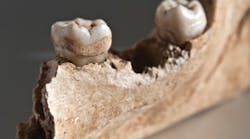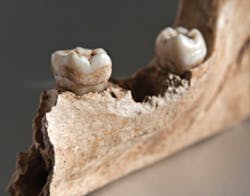Consider also reading these articles by Lynne Slim
by LYNNE SLIM, RDH, BSDH, MSDH
When explaining treatments and various regimens to patients, doctors frequently use analogies to help patients understand chemical messengers. For example, my OB/GYN once compared estrogen to a fertilizer on a lawn, which helps it grow and flourish. Progesterone was compared to a lawn mower to cut grass back to its original size. If no progesterone is part of the menstrual cycle, the grass continues to grow.
Lynn Gamarel, RDH, posted an analogy on the Listers blog (AmyRDH.com) that appealed to me and it went something like this: Imagine your tooth as a castle. Some castles have moats, and a moat is a big trench or ditch that surrounds a castle. It is usually but not always filled with water. A moat with stagnant water would be nasty because sometimes sewage would have been dipped straight into the stagnant water. Imagine the smell, especially on a hot summer's day! Think of a moat as your gum line and recognize that many of the moat's (gum line) inhabitants live underneath.
Lynn emphasizes that brushing alone won't keep the gum line clean and she likes to point out that the population of invisible bacteria in the gum line "moat" doubles daily.
I wrote to Lynn and told her I read an article in the February 2013 issue of National Geographic magazine about a research team who collected dental calculus on ancient teeth from 34 human skeletons.1 Calculus from hunter-gatherer skeletons who lived about 7,500 years ago was compared to calculus from farming medieval skeletons, approximately 1,000 years old. Data from these skeletons indicate that the transition from hunter-gatherer to farming shifted the oral microbial community to a disease-associated one. We already know that two of the greatest dietary shifts in human evolution took place when carbohydrate-rich farming diets and modern processed diets with flour and sugar took over partly as a result of the industrial revolution.
The composition of the oral microbiota changed in modern man and cariogenic bacteria became dominant. Modern oral microbiotic ecosystems became less diverse compared to ecosystems of historic man. This gradual change has also been described as the end of the happy co-evolution between bacteria and humans. Is it possible that the gradual change in the oral microbiotic ecosystem is contributing to chronic oral (and other) disease in postindustrial lifestyles? When we talk about oral-systemic links, are some of these statistically significant links related to diet/lifestyle and an aging body that is living twice as long as hunter-gatherers?
Hunter-gatherers were found to have a diverse array of bacteria and some are associated with good health. Among modern or prehistoric hunter-gatherers, there was a relative absence of dental caries or periodontal disease.
Alan Cooper from the University of Adelaide who studied these preserved microbes (and their DNA) is quoted in National Geographic, and his comments are poignant. He says, "Eating all this soft, squishy carbohydrate and leaving it lying around the base of your teeth is effectively inviting in a whole new range of bugs to take up residence in your mouth."
Cooper is curious about what would happen if he transplanted certain types of bacteria that are common in a hunter-gatherer into the mouths of people on low-carbohydrate diets. He believes that a healthy mouth has a more diverse population of bugs, which is just the opposite of what you might think is best.
Even though dietary changes are thought to be the main cause of large shifts in bacterial diversity, societal changes are important variables to consider (sedentary lifestyles, urbanization, and the domestication of animals). Improved oral hygiene, too, may have contributed to the observed decline in oral microbial diversity in modern populations as humans disrupt oral biofilms more frequently.
I recently communicated with one of Dr. Cooper's assistants, Laura, and we discussed the modern-day oral bacterial ecosystem. She described it as significantly changed, even during the past 200 years, to contain oral pathogens that weren't there even a few thousand years ago. Even in healthy, modern-day individuals, there are more oral pathogens and a much less diverse overall population, which makes us more susceptible to new diseases in what Alan Cooper calls a permanent "diseased" state.
Dr. Cooper's team, which included Laura, found Porphyromonas gingivalis in the mouths of hunter-gatherers, as well as in modern skeletons. To them, this suggests that this species has significantly changed throughout time, because periodontitis wasn't common in the hunter-gatherer's mouth, even though P. gingivalis was commonly found. The team also found Streptococcus mutans in people from the early Bronze Age, but not in hunter-gatherers (other Streptococcus species appeared to fill that ecological niche in the hunter-gatherer's mouth). Because of the dates that coincide with the prevalence of S. mutans in their study, they hypothesized that diet is what allowed S. mutans to become prevalent in the mouth, along with numerous other species that are not identified in the hunter-gatherer mouth.
Because our modern diet contains so much sugar and carbohydrates, certain bacteria can use it effectively as nourishment, and the result has been the loss of the mouth's natural microbiome, leaving the path open for invasion and dominance of disease-causing bacteria. Pathogens are winning, and they may be killing us in the process. When aggressive bacteria break away during a routine dental cleaning and escape into the bloodstream, this may be deadly for some patients.
Dr. Cooper makes a curious comment in National Geographic and says we should "avoid mouthwash." He's not really saying that we need to stop it completely, but he's making the point that we should avoid anything that decreases bacterial diversity in our bodies. This decrease in diversity is likely being caused by the carbohydrate/sugar rich modern-day diet, the high use of antibiotics, and unknown chemical exposures to our bodies. This decrease in bacterial diversity is also what researchers are linking to numerous Western systemic diseases — for example, obesity, diabetes, heart disease, and even autism.
The take-home message, according to Laura, is that we need to be cognizant of how our daily lives impact the microflora in our bodies and probably avoid anything, even sometimes mouthwash, that kills bacteria that were meant to be there. We need to remember that our bodies are actually 10 times more bacteria than human cells, and they've evolved with us for millions of years. There's a good reason why they're there.
Instead of our obsession with oral-systemic links in dentistry as cause/effect, let's focus instead on our modern "polluted" lifestyle and help our patients get healthy. These statistical (perio-systemic) associations are probably also associated with a common denominator that is often overlooked: a long-living population and a 21st century polluted lifestyle.
I told Lynn Gamarel that the moats around the necks of our teeth are not only stinky but polluted, too. RDH
LYNNE SLIM, RDH, BSDH, MSDH, is an awardwinning writer who has published extensively in dental/dental hygiene journals. Lynne is the CEO of Perio C Dent, a dental practice management company that specializes in the incorporation of conservative periodontal therapy into the hygiene department of dental practices. Lynne is also the owner and moderator of the periotherapist yahoo group: www.yahoogroups.com/group/periotherapist. Lynne speaks on the topic of conservative periodontal therapy and other dental hygiene-related topics. She can be reached at [email protected] or www.periocdent.com.
Reference
1. http://phenomena.nationalgeographic.com/2013/02/17/prehistoric-plaque-and-the-gentrification-of-europes-mouth/
Past RDH Issues







